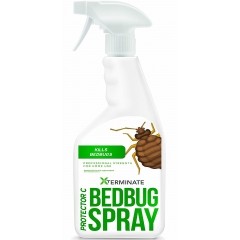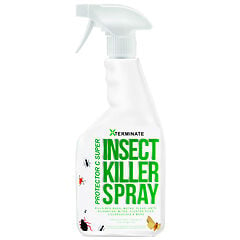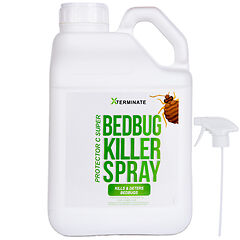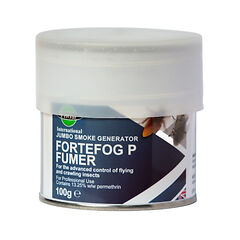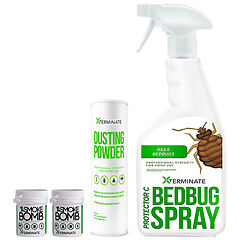
Bed Bug Killer
Dealing with bed bugs is never a fun experience, but our range of professional-quality pest control supplies will help you get rid of them as quickly as possible. We've got everything from smoke bombs to growth inhibitor sprays to limit and exterminate bed bug infestations - fast!
Bed Bugs
Bed bugs are an increasingly common problem in the UK. Rising temperatures and a growing population are creating the perfect conditions for these bloodsucking parasites to thrive. That means it’s more important than ever to know how to spot bed bugs and how to get rid of them.
What Are Bed Bugs?
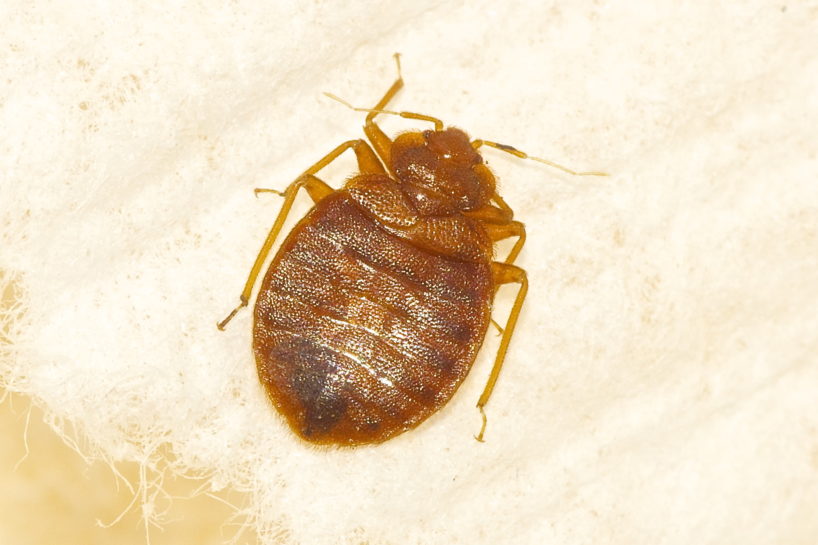 Bed bugs are bloodsucking parasites that take their names from their preferred hunting grounds – our beds. While they can survive almost anywhere at a push - which is one of the reasons they’re so tricky to get rid of – our beds provide them with everything they need. They’re soft, dark, just the right temperature, and, most importantly, they give the bugs a regular supply of blood to feed on.
Bed bugs are bloodsucking parasites that take their names from their preferred hunting grounds – our beds. While they can survive almost anywhere at a push - which is one of the reasons they’re so tricky to get rid of – our beds provide them with everything they need. They’re soft, dark, just the right temperature, and, most importantly, they give the bugs a regular supply of blood to feed on.
How Do Bed Bugs Breed?
The way bed bugs mate is unusual, but it’s one of the reasons behind why they spread so quickly. The male climbs onto the female and stabs her through the side of her abdomen with a special needle-like reproductive organ. After that, the female has to find a blood meal before she can lay her eggs. However, after they find that blood meal, they can lay around 500 eggs in a lifetime provided they have a regular supply of blood!
As you might imagine, being stabbed in the side is quite traumatic for the female, which means pregnant bed bugs will try to isolate themselves from males. This leads to them striking out on their own, where they’ll often end up in sofas, clothing, luggage, public transport, and any other place they can find regular blood meals. What this all means is that female bed bugs have evolved to constantly be on the lookout for new places to lay their eggs, so they can spread very quickly.
The Bed Bug Life Cycle
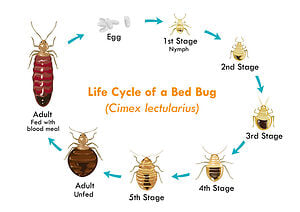 Bed bug life cycles speed up in warm weather. This means, as temperatures rise across the globe, bed bugs are growing and breeding faster than ever before! Once an egg is laid, it hatches in 6-17 days depending on how warm it is. Hatched eggs are known as nymphs. After a nymph hatches, it grows and sheds its skin five times before it becomes fully mature, and it needs a blood meal before it moves onto the next stage of its life cycle.
Bed bug life cycles speed up in warm weather. This means, as temperatures rise across the globe, bed bugs are growing and breeding faster than ever before! Once an egg is laid, it hatches in 6-17 days depending on how warm it is. Hatched eggs are known as nymphs. After a nymph hatches, it grows and sheds its skin five times before it becomes fully mature, and it needs a blood meal before it moves onto the next stage of its life cycle.
Bed bugs need to be fully grown before they can breed, but in the right conditions, this can take as little as three weeks. What this means is that, if you’re trying to get rid of bed bugs, you need to make sure you’re getting rid of every single one. If you leave any in your home, they’ll be back with a vengeance in a matter of weeks.
How to Identify Bed Bugs
Most people don’t realise they have bed bugs until they start showing up in itchy red bites. These bites will appear in straight lines or patterns on any part of the body. If you notice suspicious bites on your body, check your mattress, pillows, bedsheets, and bed frame for any signs of bed bugs. You should look for the bugs themselves, their small white eggs, shed skin, and small spots of blood on your sheets.
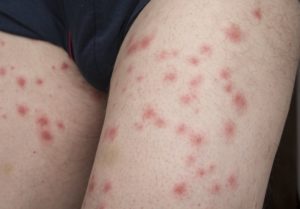 Bear in mind, though, that the itchy red bite marks are actually caused by an allergic reaction to the bed bug saliva, not the bites themselves. Some people are immune to this reaction, so they can be bitten and show no symptoms at all. If you share a bed with a partner and only one of you is suffering from an itchy rash, don’t rule out bed bugs as a potential cause - check your bed thoroughly just to be sure!
Bear in mind, though, that the itchy red bite marks are actually caused by an allergic reaction to the bed bug saliva, not the bites themselves. Some people are immune to this reaction, so they can be bitten and show no symptoms at all. If you share a bed with a partner and only one of you is suffering from an itchy rash, don’t rule out bed bugs as a potential cause - check your bed thoroughly just to be sure!
Are You at Risk of Bed Bugs?
As bed bugs are so tough to get rid of, it’s much better to ensure you never get them in the first place! While they’re increasingly common all over the UK, some places are more at risk than others. Built-up areas are most at risk, so if you live somewhere like Central London or Birmingham you should be extra-vigilant. People who catch public transport a lot are also at risk, especially in big cities. Bus and train seats are the perfect home for a bed bug, so be sure to check the seat carefully before you sit down.
It’s a common misconception that bed bugs only strike in unhygienic places. This isn’t true at all; they’re not attracted to dirt and can be found in luxury penthouses and five-star hotels! Bed bugs are attracted to body heat and that’s about it.
How Do You Catch Bed Bugs?
 Commonly, they’re picked up while travelling. They can hitch a ride on clothing, in bags, and in luggage. Unlike fleas, bed bugs are quite slow and don’t jump, so they’ll usually only be able to climb onto you if you sit down on an infested seat, or if you leave baggage or items of clothing on carpets.
Commonly, they’re picked up while travelling. They can hitch a ride on clothing, in bags, and in luggage. Unlike fleas, bed bugs are quite slow and don’t jump, so they’ll usually only be able to climb onto you if you sit down on an infested seat, or if you leave baggage or items of clothing on carpets.
You can bring home a bed bug from almost any public place, and if that bug happens to be pregnant you could be left with a full-scale infestation in a matter of weeks. You can take measures to protect yourself against them, though. These include:
- When you check into a hotel, put your bags in the bathroom and thoroughly check the bed and carpets for signs of bugs. As the bathroom is full of hard surfaces, your bags should be safe in there while you give them room a good going-over.
- Check bus and train seats before you sit down by running your hand over them and examining them for signs of eggs or shells. You can also examine the crevices where the seat cushion meets the seat frame as this is where the pests are most likely to be. Use the insect-repelling Deet cream whenever you travel on public transport just to be sure!
- When buying second-hand clothing or furniture, make sure you check them thoroughly before you bring them into your home.
You might feel a bit silly doing this all the time, but if it prevents you from bringing home a bed bug infestation, it’ll all be worth it!
How Do You Get Rid of Bed Bugs?
Bed bugs can survive almost anything and are great at hiding, which makes them tricky to get rid of. However, it is possible, and you don’t need to spend hundreds on a professional exterminator to get it done! All of the products you’ll find on this page are professional-grade and will get the job done if used correctly. There are a few golden rules you need to remember at all times when dealing with bed bugs, which are:
Use Multiple Methods of Attack
 You’d be amazed at the things bed bugs can survive. They’re adaptable and can slip into the tiniest nooks and crannies to escape danger. This means using just one pest control product against them isn’t effective as it’s a guarantee that some will manage to get away. If you use several, then you’ll get much more coverage and end up with better results.
You’d be amazed at the things bed bugs can survive. They’re adaptable and can slip into the tiniest nooks and crannies to escape danger. This means using just one pest control product against them isn’t effective as it’s a guarantee that some will manage to get away. If you use several, then you’ll get much more coverage and end up with better results.
Let’s say you use a smoke bomb, a dusting powder, and a surface spray in your bedroom. The fumer will kill most of the bed bugs, but some will still try and escape into your bed frame or through gaps in your skirting. If you fully cover these areas in spray and powder, this will do a great job of mopping up the rest!
Re-Treatment
The most important thing you can do with a bed bug infestation is to re-treat a few days later. This is because the only things more adaptable than the adult bugs are their eggs! Eggs can survive almost anything, from insecticides to high or low temperatures, so even if you wipe out every last bug from your home, there will likely still be a few eggs left. That’s why re-treating an area is absolutely vital to prevent the infestation from returning again. This will mop up any surviving eggs, whether they’ve hatched or not.
Xterminate Protector C Super Spray
Your best tool for getting rid of bed bugs for good is Xterminate Bed Bug Killer spray. It is both an insecticide and a growth inhibitor. What this means is that it kills most bed bugs who come into contact with it, but – as with any pesticide – it won’t kill them all. What it does do is prevent the bugs from advancing to the next stage of their life cycle, meaning that any nymphs that aren’t fully mature won’t be able to lay any more eggs. Any surviving eggs can still hatch, but they won’t be able to grow past the first stage of their life cycle. This stops the bugs from breeding and prevents infestations from returning!
Wash Everything at 60°C
When washing bedding and clothes after an infestation, be sure to wash at 60°C for a minimum of half an hour. Studies have shown that some bed bugs and especially their eggs can survive 40°C and 50°C washes, so make sure you wash everything on as hot a setting as possible.
Encase Your Mattress
 In some cases, bed bugs can infest the core of a mattress. When this happens, they’re especially difficult to get rid of as most pest control products won’t be able to reach them. In these cases, it might be best to bin the mattress entirely and buy a new one. However, if it’s an expensive mattress or if you’re confident the infestation wasn’t too bad, there is another way: you can fit your mattress with a special bed bug-proof mattress protector.
In some cases, bed bugs can infest the core of a mattress. When this happens, they’re especially difficult to get rid of as most pest control products won’t be able to reach them. In these cases, it might be best to bin the mattress entirely and buy a new one. However, if it’s an expensive mattress or if you’re confident the infestation wasn’t too bad, there is another way: you can fit your mattress with a special bed bug-proof mattress protector.
This is a process known as “encasement”. It involves completely sealing your mattress with a dust-proof cover. This means that no bed bugs can get out, leaving them trapped inside your mattress to eventually die off. It also stops them from escaping inside your mattress, meaning there’s one less place to hide when you use your treatments.



